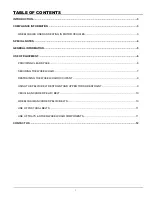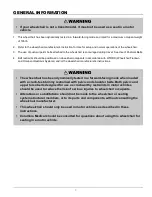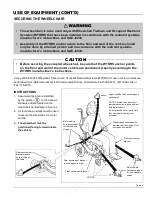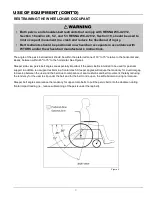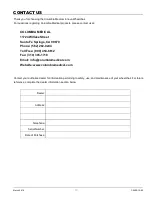
3
This guide includes important information regarding the use of the Columbia Medical Innova
™
transit wheelchair which
has been equipped with transit ready securement brackets. Please read it carefully and keep it for future reference.
When riding aboard a motor vehicle, it is recommended that a wheelchair user transfer from the wheelchair into the
vehicle seat and use a crash-tested restraint system that meets federal standards when possible.
However, some wheelchair users are unable to transfer to the vehicle seat. In those cases, Columbia Medical Innova
transit wheelchair offers a transportation seating alternative.
Columbia Medical transit wheelchairs comply with the wheelchair transportation standard.
Proper securement of your Columbia Medical Innova transit wheelchair with properly applied occupant restraints can
signifi cantly reduce the likelihood of injury in the event of a motor vehicle crash.
This guide provides instructions for how to correctly secure the Columbia Medical wheelchair in a bus or van and
safely restrain the wheelchair occupant.
This wheelchair complies with the frontal impact performance requirements of section 5.3 of RESNA WC-4:2012,
Section 19.
RESNA = Rehabilitation Engineering Society of North America
WHEELCHAIR USED AS SEATING IN MOTOR VEHICLES
This wheelchair has been dynamically tested in a forward-facing mode with a 130 lb. crash test dummy, which
corresponds to a person with a weight of 125 lb - 165 lb. This wheelchair was tested with a WC19 wheelchair
compliant anchored pelvic belt restraint in accordance with RESNA WC-4:2012, Section 19.
Four wheelchair tiedown straps should be used for effective wheelchair securement.
BOTH pelvic and upper torso occupant restraints should be used to reduce the possibility of head and chest impacts
with vehicle components.
Mass of wheelchair: 73 lb / 33.2 kg (with seating system)
Minimum turnaround width of wheelchair: 50 inches / 1270 mm
Minimum turning radius of wheelchair: 35 inches / 889 mm
Rating of wheelchair accommodation of vehicle anchored belt restraints:
•
Ease of Optimizing Proper Seat Belt Placement: B* (Good)
•
Overall Rating: A* (Excellent); Score: 16/16
•
Lateral stability**: Good
*Rating scale: A-Excellent; B-Good; C-Fair; D-Poor
**Lateral stability is the displacement of point P (the center of gravity on the loaded wheelchair), when a platform with
the loaded wheelchair is tilted 45 degrees laterally from the horizontal. Higher numbers indicate less stability.
INTRODUCTION
COMPLIANCE INFORMATION


